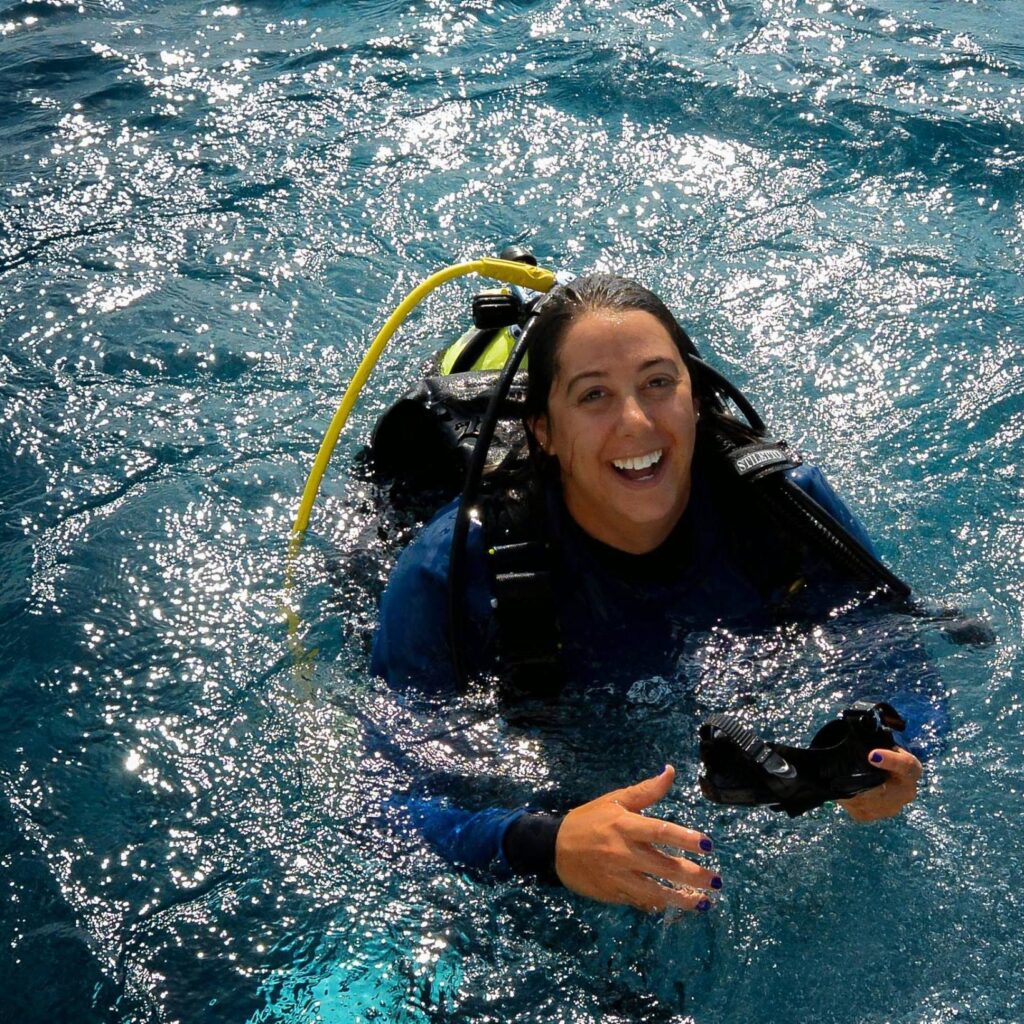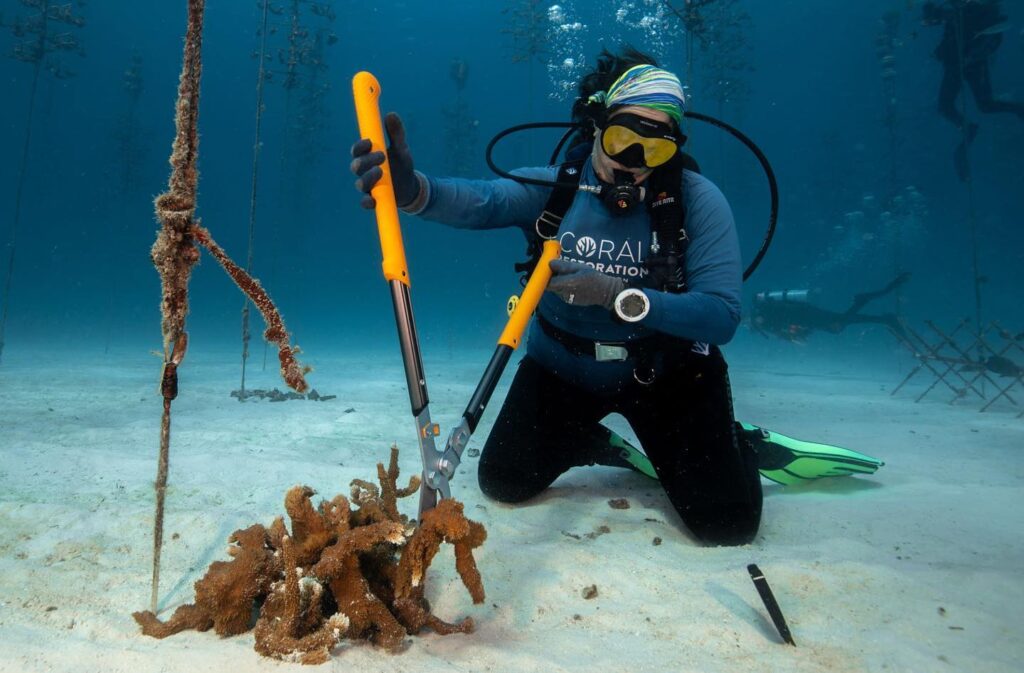By Ali Barton, FAU School of Communication and Multimedia Studies
The following is a Q&A conducted with Jessica Levy, director of restoration strategy for the Coral Restoration Foundation in Key Largo, where she began as a volunteer. Levy earned a bachelor’s degree in marine science from the University of North Carolina at Wilmington and a master’s degree in tropical ecology and conservation from James Cook University in Australia. This interview has been edited for length and clarity.
What does the Coral Restoration Foundation do to restore the coral reefs affected by climate change?

We grow corals on coral trees. It’s a methodology that CRF actually pioneered and is now used pretty readily around the world … as our propagation method.
Corals are like plants, even though they are animals. You can cut them and make more of them, which is called asexual propagation — that’s the method we take advantage of while we are in the water. The corals are grown on these tree structures depending on the coral species because they all have different growth rates and morphologies.
After about nine months to a year, they tend to be what we call “reef ready,” which means they’re ready to be harvested from the nursery and then moved to a restoration site. Restoration sites are basically degraded reef sites. We return them to their native reefs through a process called out-planting. This process is meant to be low footprint, so we don’t use structures or anything that could cause an eyesore or look very unnatural. …
We use out-planting a variety of different species to have a more holistic approach to restoration sites and then within those species, we are promoting genetic diversity. The idea being that with climate change, disease outbreaks and the troubles the corals face, there are some that do better or worse through different stresses and at different times, so we try to build in diversity to promote resiliency within the restoration practice.
How are the coral reefs affected by climate change? How have they changed over time?
I’ve witnessed a lot of loss and degradation. It is attributed to a lot of different things, and the Keys, in particular, have a lot of issues with water quality and disease events … and, of course, we have had a few years of major bleaching events, which can be attributed to both warm water and cold-water events.
When we talk about climate change, everyone talks about heating, which is 100% true, and 99% of the time, that’s what’s going to happen in coral reefs.
Climate change is the single biggest threat to coral reefs, and it comes in the form of heat, stress and coral bleaching. But climate change is also about variability and extremes. So, you can also have extremely cold temperatures in which these corals don’t do well in either.
Most recently is the mortality event that they’re experiencing this year, which, although we’ve experienced this and I’ve seen mortality events in the past, this one is arguably the most significant. The Keys are a special place, although a lot of our coral reefs face this global issue of climate change in a lot of other locations.
What effects of climate change cause the degradation of the coral reefs? What do you do to combat the degradation?
Climate change, in its basic form, has three impacts.
There’s a potential sea-level rise, and these corals have a narrow window of where they like to live. So, if waters get deeper, that may mean that either the corals won’t live, or what you’ll see is a shift in their range. In a healthy system, they would probably be able to keep up with sea-level rise and still persist, just be located in a different place.

The second is storms, because storms are increasing in frequency and increasing in intensity. And again, in healthy coral reef systems, it’s very common to use a storm as a way to spread populations because a storm would break up the corals, like what we do in a nursery, asexual fragmentation. These corals would then reattach onto a reef and then continue to grow. That’s what they do naturally, and that’s the restoration process that we take advantage of. But when storms are so strong or so frequent, there’s no period of recovery, so they lose the ability to fragment and reattach.
The third and most significant would probably come in the form of coral bleaching, which is what we’re seeing now, where … it gets hot quickly and then they just can’t handle it. They either bleach or recover if things go back to normal. What we see now in Florida is they bleach. They basically starve to death and then die.
So, the way to manage that in restoration, and restoration as a field, actually has two camps on this. There’s this idea of what’s called “super coral,” which is basically a coral that’s been bred or selected to have certain traits over others to essentially make it more fit … and the other camp that CRF fits into is this camp of large genetic diversity.
If you work with a lot of different genotypes of these corals, some are going to be resistant to some stress and others are going to be resistant to other stressors. And like we said, climate change is about that variability. So, we try to put out hundreds of different genotypes so that with understanding that some are going to live and some are going to die. You keep doing this in large quantities so that you can maintain that population, even though you’re going through a lot of uncertainty and changes.
What are ways that everyday people can help slow climate change and its effects on the coral reefs and the environment as a whole?
First and foremost … coming into an election year for us in the states, vote for climate-savvy and ocean-minded people, and support people who support climate-friendly legislation. A huge part of what people can do is to have their voices heard and do what they can at the policy and decision-making level.
The other thing people can do as individuals is make modifications to personal behaviors. It really is simple things like carpooling or taking public transportation over driving all the time, making sustainable choices, seafood diets, using reef-safe sunscreens at the beach, and all of these can make a huge difference. It’s about progress, not perfection.
What’s one piece of advice you would give my generation to become more conscious of our actions and their effects on the environment?
I just went to a conference, and I heard a quote that hit home to me, and I wish more people would advise this relating to sustainability. The quote is, “Sustainability is one generation using resources that they need while leaving enough resources for the following generation.”
There’s a lot of people coming behind us. My advice is to really think more sustainable and think more about what comes next.
This Q&A was conducted by Ali Barton, a sophomore majoring in multimedia journalism at Florida Atlantic University.
Sign up for The Invading Sea newsletter by visiting here. If you are interested in submitting an opinion piece to The Invading Sea, email Editor Nathan Crabbe at ncrabbe@fau.edu.



